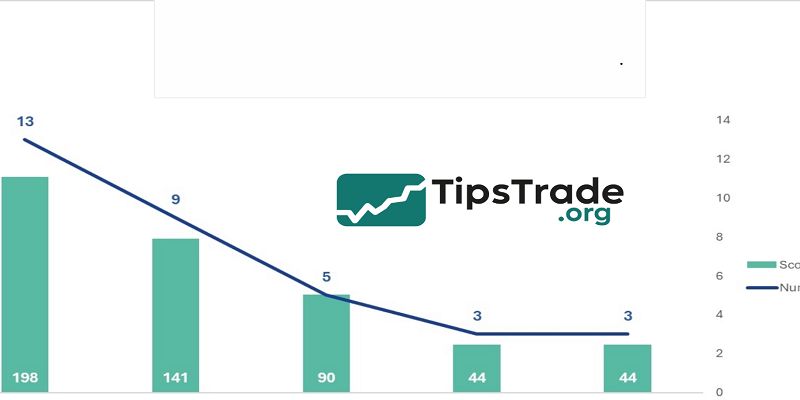Factors affecting the stock market play a significant role in shaping investor decisions and market trends. These factors include economic indicators, political events, company performance, and global issues. Understanding these influences helps investors anticipate market movements and manage risks effectively. Analyzing these factors is essential for making informed investment choices. Visit tipstrade.org and check out the article below for further information
Factors Affecting the Stock Market

GDP Growth and Economic Performance
- Gross Domestic Product (GDP) reflects the health of an economy and often correlates directly with stock market performance.
- When GDP grows steadily, companies typically experience higher revenues, boosting investor confidence and stock prices.
- Conversely, during recessions or periods of stagnation, lower consumer spending and reduced corporate profits may lead to declining equity markets.
- For example, during the post-pandemic recovery in 2021, the U.S. GDP surged over 5.7% — its fastest growth since 1984 — and the S&P 500 gained nearly 27% that year (source: U.S. Bureau of Economic Analysis). GDP data is thus a key barometer for predicting market sentiment and corporate earnings.
Interest Rates and Monetary Policy
- Interest rates are among the most powerful factors affecting the stock market.
- When central banks raise rates to curb inflation, borrowing costs increase for both consumers and businesses, reducing corporate profits and slowing economic expansion.
- This often leads to lower stock valuations, especially in growth-oriented sectors.
- Conversely, lower interest rates stimulate borrowing and investment, fueling stock market rallies.
- The Federal Reserve’s near-zero interest rate policy during 2020–2021 helped push U.S. equities to record highs.
- Investors closely monitor central bank statements, as even small policy shifts can ripple through global markets.
Inflation and Consumer Purchasing Power
- Inflation erodes the real value of money and directly impacts corporate earnings and consumer behavior.
- Moderate inflation (around 2%) is generally healthy, signaling steady demand.
- However, high inflation can hurt profit margins as companies struggle to pass rising costs onto consumers.
- Between 2022 and 2023, global inflation spikes led to volatile stock performances as investors feared monetary tightening.
- Defensive sectors like utilities and consumer staples often outperform in such periods, while growth stocks tend to suffer.
- Monitoring inflation trends helps investors adjust portfolios toward resilient assets.
Exchange Rates and International Trade
- Exchange rates influence multinational corporations’ revenues, export competitiveness, and overall market performance.
- A strong domestic currency can hurt exporters by making their products more expensive abroad, while a weaker currency boosts export demand and earnings.
- For example, a stronger U.S. dollar in 2022 pressured tech giants with significant overseas exposure, reducing the value of foreign income in dollar terms.
- On the other hand, emerging markets often benefit from stable currency environments that attract foreign investment. Traders use currency indicators as early signals for market shifts.
>>See more:
- What is Industry Comparison and How to do it?
- What are Profitability Ratios? Types & Its Significance
- Key Stock Valuation Ratios and When to Use Which One
- How to Read Financial Statements Like a Pro in Stock Investment
Earnings Reports and Financial Performance

- Corporate earnings are a direct reflection of a company’s profitability and operational health.
- Quarterly earnings reports can significantly influence short-term stock prices — positive results often lead to rallies, while missed expectations can trigger sell-offs.
- Investors analyze key metrics such as earnings per share (EPS), revenue growth, and profit margins.
- For instance, when Apple Inc. reported higher-than-expected earnings in Q2 2024, its stock rose 8% within a week.
- Consistent earnings growth builds investor confidence and long-term value.
Growth Prospects and Market Expectations
- Beyond current profits, investors price in future growth potential. Companies with strong innovation pipelines, scalable business models, or access to emerging markets often command higher valuations.
- However, unrealistic expectations can lead to volatility when reality falls short.
- Tesla’s 2020–2022 rally exemplifies this dynamic: soaring growth projections drove prices sky-high, but later corrections reflected revised outlooks.
- Assessing both actual performance and future potential helps investors avoid over- or undervaluation traps.
Capital Structure, Dividends, and Liquidity
- A company’s capital structure — the mix of debt and equity — impacts financial stability and investor perception.
- High leverage increases risk during downturns but may enhance returns in growth phases.
- Dividend policies also play a role: consistent payouts signal strong cash flow, attracting income-focused investors.
- Liquidity, or the ease of buying and selling a stock, affects price stability.
- Highly liquid stocks in large exchanges like the NYSE or NASDAQ are less prone to manipulation and large price swings than illiquid small-cap shares.
Corporate Governance and Management Quality
- Strong governance practices enhance transparency and investor trust. Companies with clear reporting, ethical leadership, and independent boards often perform better over time.
- Scandals or mismanagement, however, can destroy market value rapidly.
- For example, the 2015 Volkswagen emissions scandal wiped out over $30 billion in market capitalization within weeks.
- On the other hand, well-governed firms such as Microsoft are rewarded for consistency and reliability. Governance quality is therefore a crucial long-term market driver.
Technical, Sentiment, and Market-Trend Factors

Trading Volume and Market Liquidity
- Trading volume signals the intensity of market participation. Rising volumes during price increases indicate strong momentum, while declining volume may suggest weakening trends.
- Institutional investors often track liquidity levels to gauge market strength and volatility risk.
- For example, during the 2020 recovery, record trading volumes in U.S. tech stocks reflected high retail participation through platforms like Robinhood. Liquidity ensures smoother transactions and narrower bid-ask spreads, supporting stable prices.
Investor Sentiment: Fear and Greed
- Investor psychology is one of the most intangible yet powerful factors affecting the stock market.
- Greed drives buying during bullish phases, while fear causes panic-selling during downturns.
- The CNN Fear & Greed Index quantifies this sentiment using metrics like volatility, junk bond demand, and market breadth.
- Warren Buffett’s famous advice — “Be fearful when others are greedy and greedy when others are fearful” — captures how sentiment often overshoots fundamentals.
- Successful investors learn to recognize and capitalize on these emotional extremes.
Market Trends, Herd Behavior, and Momentum
- Trends often emerge from collective investor behavior.
- Technical analysts use moving averages, support/resistance levels, and momentum indicators to identify trend direction.
- When investors follow others blindly, herd behavior can amplify price movements — both upward and downward.
- For instance, meme stocks like GameStop and AMC surged in early 2021 due to social-media-driven momentum rather than fundamentals.
- Understanding how trends form and fade helps investors manage timing and avoid emotional trading traps.
News, Events, and Market Volatility
- Breaking news — from earnings surprises to policy announcements — can trigger rapid market shifts.
- Volatility indices (like the VIX) measure expected turbulence, helping investors hedge risk.
- For example, unexpected inflation data or geopolitical tensions can spark sell-offs even in fundamentally strong markets.
- Active traders often monitor news calendars and volatility indicators to anticipate short-term moves. Maintaining discipline amid uncertainty is key to long-term success.
Political, Geopolitical, and External Shocks

Government Policy and Regulation
- Regulatory frameworks, taxation policies, and fiscal stimulus measures directly shape corporate profitability and investor confidence.
- Markets generally favor predictable, business-friendly policies.
- For instance, the 2017 U.S. corporate tax reform spurred record stock buybacks and boosted market valuations.
- Conversely, sudden regulatory crackdowns — like China’s 2021 tech-sector reforms — can erase billions in market capitalization overnight.
- Investors closely watch policy announcements to adjust risk exposure.
Geopolitical Tensions and Trade Wars
- Geopolitical risk is an increasingly important factor affecting the stock market.
- Conflicts, sanctions, or trade disputes can disrupt supply chains and investor sentiment globally.
- During the U.S.–China trade war (2018–2020), tariffs on hundreds of billions of dollars in goods rattled markets worldwide.
- Defensive sectors (e.g. defense, utilities, healthcare) often outperform during such uncertainty, while export-driven industries face pressure.
- Global diversification can mitigate exposure to regional shocks.
Natural Disasters, Pandemics, and Crises
- External shocks such as earthquakes, hurricanes, or pandemics can cause sudden market downturns.
- The COVID-19 pandemic in early 2020 led to the fastest 30% stock decline in U.S. history — followed by an equally rapid recovery driven by fiscal stimulus and digital-economy growth.
- While such crises are unpredictable, resilient portfolios emphasize diversification, cash reserves, and defensive assets.
- Investors who stay disciplined and long-term focused often recover faster post-crisis.
Technological Disruption and Sector Shifts
- Innovation reshapes industries, creating winners and losers.
- Artificial intelligence, renewable energy, and automation are transforming corporate earnings and investment flows.
- For example, the rise of AI stocks like NVIDIA and AMD in 2023–2025 demonstrates how technological breakthroughs can redefine market leadership. Understanding sectoral shifts allows investors to capture emerging trends early while managing obsolescence risk in traditional industries.
Applying Market Factors in Investment Strategy

Building a Factor-Based Portfolio
- Investors can design portfolios that account for macroeconomic and sector-specific influences.
- For instance, during inflationary periods, energy and commodities often outperform, while rate-sensitive sectors like real estate may lag.
- Diversification across geographies, industries, and asset classes reduces exposure to any single factor.
- Exchange-Traded Funds (ETFs) tracking factor indexes (e.g. momentum, value, quality) are popular tools for this strategy.
Monitoring Economic Indicators
- Keeping track of leading indicators — GDP growth, inflation data, and consumer confidence — helps anticipate market trends.
- Many traders use calendars from sources like Bloomberg Economics or Trading Economics to stay updated.
- Systematic monitoring ensures investors react to data rather than emotion, aligning decisions with evidence-based analysis.
Combining Fundamental, Technical, and Sentiment Analysis
No single approach captures the full market picture. Combining multiple perspectives provides a balanced view:
- Fundamental analysis reveals intrinsic value.
- Technical analysis detects timing and trend strength.
- Sentiment analysis gauges crowd behavior.
Integrating these methods enhances accuracy and adaptability across market cycles.
Risk Management and Contingency Planning
- Markets are inherently uncertain. Using stop-loss orders, hedging instruments, and asset allocation models protects against downside risks.
- Professional investors maintain liquidity buffers and scenario plans for events like recessions or geopolitical shocks.
- Effective risk management transforms volatility from a threat into an opportunity.
Conclusion
Factors affecting the stock market continue to evolve with changes in the global economy and geopolitical landscape. Staying aware of these variables enables investors to adapt strategies and seize opportunities. A comprehensive understanding of these factors is key to navigating the complexities of the stock market successfully.
See more:

